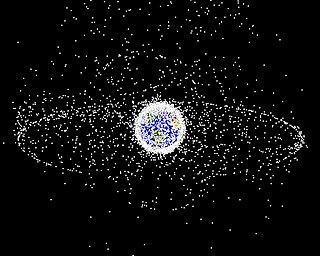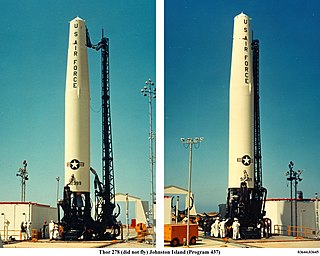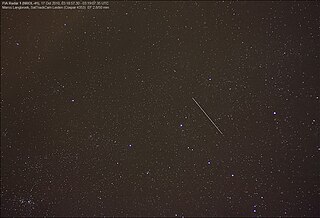
Anti-satellite weapons (ASAT) are space weapons designed to incapacitate or destroy satellites for strategic or tactical purposes. Although no ASAT system has yet been utilised in warfare, a few countries have successfully shot down their own satellites to demonstrate their ASAT capabilities in a show of force. ASATs have also been used to remove decommissioned satellites.

Space debris are defunct human-made objects in space – principally in Earth orbit – which no longer serve a useful function. These include derelict spacecraft – nonfunctional spacecraft and abandoned launch vehicle stages – mission-related debris, and particularly numerous in Earth orbit, fragmentation debris from the breakup of derelict rocket bodies and spacecraft. In addition to derelict human-made objects left in orbit, other examples of space debris include fragments from their disintegration, erosion and collisions or even paint flecks, solidified liquids expelled from spacecraft, and unburned particles from solid rocket motors. Space debris represents a risk to spacecraft.

The National Reconnaissance Office (NRO) is a member of the United States Intelligence Community and an agency of the United States Department of Defense which designs, builds, launches, and operates the reconnaissance satellites of the U.S. federal government, and provides satellite intelligence to several government agencies, particularly signals intelligence (SIGINT) to the NSA, imagery intelligence (IMINT) to the NGA, and measurement and signature intelligence (MASINT) to the DIA. The NRO announced in 2023 that it plans within the following decade to quadruple the number of satellites it operates and increase the number of signals and images it delivers by a factor of ten.

USS Lake Erie (CG-70) is a Ticonderoga-class guided missile cruiser of the United States Navy, commissioned in 1993. She was named after the U.S. Navy's decisive victory in the Battle of Lake Erie during the War of 1812. The cruiser was the first U.S. Navy ship to be commissioned in Hawaii.

The Space-Based Infrared System (SBIRS) is a United States Space Force system intended to meet the United States' Department of Defense infrared space surveillance needs through the first two to three decades of the 21st century. The SBIRS program is designed to provide key capabilities in the areas of missile warning, missile defense, battlespace characterization and technical intelligence via satellites in geosynchronous Earth orbit (GEO), sensors hosted on satellites in highly elliptical orbit (HEO), and ground-based data processing and control.

Space warfare is combat in which one or more belligerents are situated in outer space. The scope of space warfare therefore includes ground-to-space warfare, such as attacking satellites from the Earth; space-to-space warfare, such as satellites attacking satellites; and space-to-ground warfare, such as satellites attacking Earth-based targets. Space warfare in fiction is thus sub-genre and theme of science fiction, where it is portrayed with a range of realism and plausibility. In the real world, international treaties are in place that attempt to regulate conflicts in space and limit the installation of space weapon systems, especially nuclear weapons.

The Kessler syndrome, proposed by NASA scientist Donald J. Kessler in 1978, is a scenario in which the density of objects in low Earth orbit (LEO) due to space pollution is numerous enough that collisions between objects could cause a cascade in which each collision generates space debris that increases the likelihood of further collisions. In 2009, Kessler wrote that modeling results had concluded that the debris environment was already unstable, "such that any attempt to achieve a growth-free small debris environment by eliminating sources of past debris will likely fail because fragments from future collisions will be generated faster than atmospheric drag will remove them". One implication is that the distribution of debris in orbit could render space activities and the use of satellites in specific orbital ranges difficult for many generations.

Program 437 was the second anti-satellite weapons program of the U.S. military. The US anti-satellite weapons program began development in the early 1960s and was officially discontinued on 1 April 1975. Program 437 was approved for development by U.S. Secretary of Defense Robert McNamara on November 20, 1962, after a series of tests involving high altitude nuclear explosions. The program's facilities were located on Johnston Island, an isolated island in the north central Pacific Ocean.

Future Imagery Architecture (FIA) was a program awarded to Boeing to design a new generation of optical and radar imaging US reconnaissance satellites for the National Reconnaissance Office (NRO). In 2005 NRO director Donald Kerr recommended the project's termination, and the optical component of the program was finally cancelled in September 2005 by Director of National Intelligence John Negroponte. FIA has been called by The New York Times "perhaps the most spectacular and expensive failure in the 50-year history of American spy satellite projects." Despite the optical component's cancellation, the radar component, known as Topaz, has continued, with four satellites in orbit as of February 2016.

The ASM-135 ASAT is an air-launched anti-satellite multistage missile that was developed by Ling-Temco-Vought's LTV Aerospace division. The ASM-135 was carried exclusively by United States Air Force (USAF) F-15 Eagle fighter aircraft.
On 11 January 2007, China conducted an anti-satellite missile test. A Chinese weather satellite—the FY-1C polar orbit satellite of the Fengyun series, at an altitude of 865 kilometres (537 mi), with a mass of 750 kilograms (1,650 lb)—was destroyed by a kinetic kill vehicle traveling with a speed of 8 km/s (18,000 mph) in the opposite direction. It was launched with a multistage solid-fuel missile from Xichang Satellite Launch Center or nearby.

USA-193, also known as NRO Launch 21, was a United States military reconnaissance satellite launched on 14 December 2006. It was the first launch conducted by the United Launch Alliance (ULA). Owned by the National Reconnaissance Office (NRO), the craft's precise function and purpose were classified. On 21 February 2008, it was destroyed as a result of Operation Burnt Frost.

P78-1 or Solwind was a United States satellite launched aboard an Atlas F rocket from Vandenberg Air Force Base in California on February 24, 1979. The satellite's mission was extended by several weeks, so that it operated until it was destroyed in orbit on September 13, 1985, to test the ASM-135 ASAT anti-satellite missile.

The RIM-161 Standard Missile 3 (SM-3) is a ship-based surface-to-air missile system used by the United States Navy to intercept short- and intermediate-range ballistic missiles as a part of Aegis Ballistic Missile Defense System. Although primarily designed as an anti-ballistic missile, the SM-3 has also been employed in an anti-satellite capacity against a satellite at the lower end of low Earth orbit. The SM-3 is primarily used and tested by the United States Navy and also operated by the Japan Maritime Self-Defense Force.

USA 202, previously NRO Launch 26 or NROL-26, is a classified spacecraft which is operated by the United States National Reconnaissance Office. It is an Advanced Orion ELINT satellite. According to Aviation Week, it "fundamentally involves America's biggest, most secret and expensive military spacecraft on board the world's largest rocket." The combined cost of the spacecraft and launch vehicle has been estimated to be over US$2 billion.
Strictly speaking, a satellite collision is when two satellites collide while in orbit around a third, much larger body, such as a planet or moon. This definition can be loosely extended to include collisions between sub-orbital or escape-velocity objects with an object in orbit. Prime examples are the anti-satellite weapon tests.
China's anti-satellite (ASAT) program has been under development since 1964. The ASAT program has since been moved from Program 640 to Program 863, the General Armaments Department and the State Administration for Science, Technology and Industry for National Defense. Since its inception, the ASAT program has made progress on the development of three ASAT capable Systems: direct fire, directed-energy weapon, and microsatellites. Tests of these systems have either been directly acknowledged by the PRC, or reported on as ASAT capable. China is pursuing a broad and robust array of counterspace capabilities, which includes direct-ascent antisatellite missiles, co-orbital antisatellite systems, computer network operations, groundbased satellite jammers, and directed energy weapons.

On 27 March 2019, India tested an anti-satellite weapon (ASAT) during an operation code named Mission Shakti. The target of the test was a satellite present in a low Earth orbit, which was hit with a kinetic kill vehicle.

Kosmos-1408 was an electronic signals intelligence (ELINT) satellite operated by the Soviet Union. It was launched into low Earth orbit on 16 September 1982 at 14:55 UTC, replacing Kosmos-1378. It operated for around two years before becoming inactive and left in orbit.


















